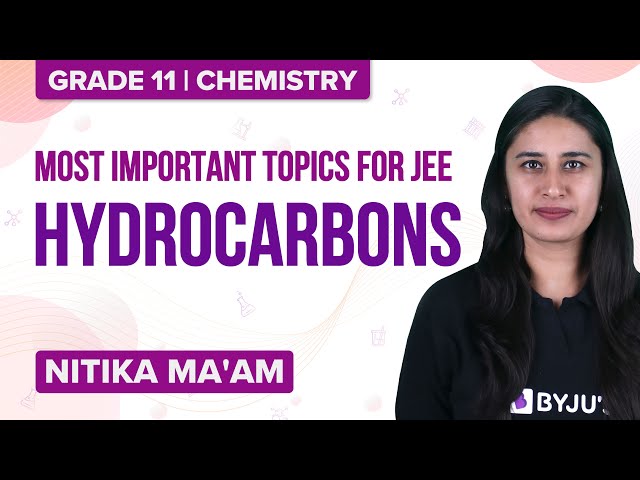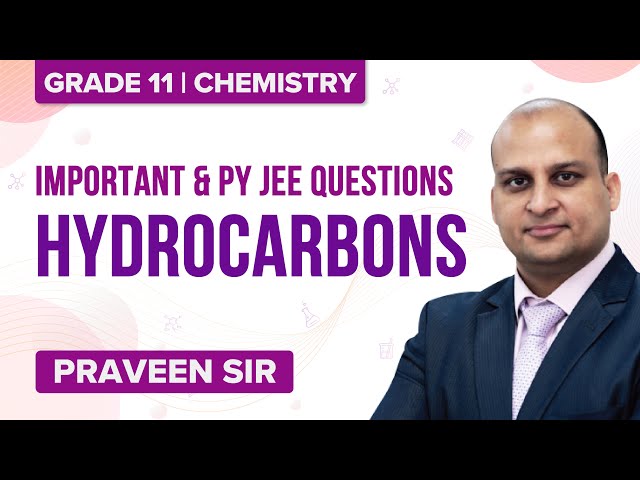Hydrocarbons JEE Advanced Previous Year Questions with Solutions are given here. With the set of questions provided students will be able to analyze and learn about the different types of questions from the chapter on hydrocarbons. Further with continuous practice in solving these types of questions, they will be able to boost their preparation and eventually score higher rank in the JEE Advanced exam.
From an exam perspective, hydrocarbon is an important topic. As students go through these questions they will gain a much better idea of what type of questions to expect from this topic. On the other hand, the solutions will also aid students in conducting quick revisions of the different topics covered in this unit.
Additionally, students can download the JEE Advanced Hydrocarbons Previous Year Questions with Solutions in a PDF format free of charge from the tab given below.
Download Hydrocarbons Previous Year Solved Questions PDF
JEE Advanced Previous Year Questions on Hydrocarbons
Question 1. In the following reactions compound x is;


Solution: (C)
The compound X is 2-phenylethanol.
The triple bond of ethynylbenzene is selectively hydrogenated to double bond by using Lindlar’s catalyst to obtain styrene.
Hydroboration oxidation of styrene gives 2-phenylethanol (compound X).

Question 2. In the following reactions compound y is;


Solution: (D)

Question 3. Isomers of hexane, based on their branching, can be divided into three distinct classes as shown in the figure.

The correct order of their boiling point is
A. I > II > III
B. II > III > I
C. III > II > I
D. III > I > II
Solution: (C)
More the branching in an alkane, lesser will be the surface area, lesser will be the boiling point as weaker will be the intermolecular attractive forces.
Question 4. The bond energy (in kcal mol-1) of a C−C single bond is approximately:
A. 1
B. 10
C. 100
D. 1000
Solution: (C)
C-C single bond dissociation energy range is between 88 to 150 Kcal mol1-1
C-C bond energy = 348J/mol = 348 / 4.2 kcal/mol
= 82.85 kcal/mol
≈ 100 kcal/mol
Question 5. The total number of stereoisomers that can exist for M is:

Solution: (2)
The total number of stereoisomers is 2.
This molecule can not show geometrical isomerism so only mirror image will be other stereoisomer.

Question 6. The total number(s) of stable conformers with non-zero dipole moment for the following compound is (are):

A. 2
B. 4
C. 3
D. 5
Solution: (C)

Three stable (staggered) conformers exist (with μ≠0)
Note: Two or more structures that are categorized as conformers differ only in terms of the angle about one or more sigma bonds.
Question 7. Newman projections P, Q, R and S are shown below:

Which one of the following options represents identical molecules?
A. P and Q
B. Q and S
C. Q and R
D. R and S
Solution: (C)

Question 8. On monochlorination of 2-methylbutane, the total number of chiral compounds obtained is.
A. 2
B. 4
C. 6
D. 8
Solution: (A)
During the monochlorination of 2 methyl butane, four compounds are possible however only two of them will be chiral in nature. Here, I and III are chiral.

Question 9. Which of the following reaction produce propane as a major product?

Solution: (B and C)

Question 10. The correct statement(s) for the following addition reactions is(are):

A. O and P are identical molecules
B. (M and O) and (N and P) are two pairs of diastereomers
C. (M and O) and (N and P) are two pairs of enantiomers
D. Bromination proceeds through trans-addition in both the reactions
Solution: (B and D)
(B) (M and O) and (N and P) are two pairs of diastereomers. They have the same configuration at one chiral carbon atom and a different configuration at other chiral carbon atoms.
(D) Bromination proceeds through trans-addition in both reactions. It involves the formation of cyclic bromonium ions.

Hydrocarbons – Important Topics

Hydrocarbons – Important & PY Questions

Comments